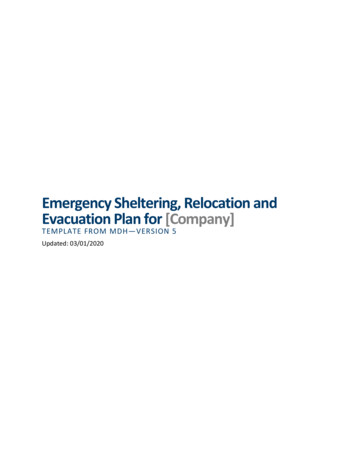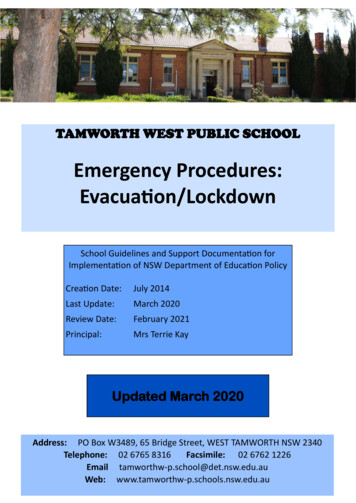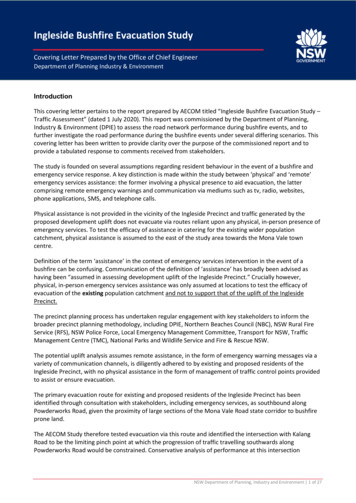
Transcription
Ingleside Bushfire Evacuation StudyCovering Letter Prepared by the Office of Chief EngineerDepartment of Planning Industry & EnvironmentIntroductionThis covering letter pertains to the report prepared by AECOM titled “Ingleside Bushfire Evacuation Study –Traffic Assessment” (dated 1 July 2020). This report was commissioned by the Department of Planning,Industry & Environment (DPIE) to assess the road network performance during bushfire events, and tofurther investigate the road performance during the bushfire events under several differing scenarios. Thiscovering letter has been written to provide clarity over the purpose of the commissioned report and toprovide a tabulated response to comments received from stakeholders.The study is founded on several assumptions regarding resident behaviour in the event of a bushfire andemergency service response. A key distinction is made within the study between ‘physical’ and ‘remote’emergency services assistance: the former involving a physical presence to aid evacuation, the lattercomprising remote emergency warnings and communication via mediums such as tv, radio, websites,phone applications, SMS, and telephone calls.Physical assistance is not provided in the vicinity of the Ingleside Precinct and traffic generated by theproposed development uplift does not evacuate via routes reliant upon any physical, in-person presence ofemergency services. To test the efficacy of assistance in catering for the existing wider populationcatchment, physical assistance is assumed to the east of the study area towards the Mona Vale towncentre.Definition of the term ‘assistance’ in the context of emergency services intervention in the event of abushfire can be confusing. Communication of the definition of ‘assistance’ has broadly been advised ashaving been “assumed in assessing development uplift of the Ingleside Precinct.” Crucially however,physical, in-person emergency services assistance was only assumed at locations to test the efficacy ofevacuation of the existing population catchment and not to support that of the uplift of the InglesidePrecinct.The precinct planning process has undertaken regular engagement with key stakeholders to inform thebroader precinct planning methodology, including DPIE, Northern Beaches Council (NBC), NSW Rural FireService (RFS), NSW Police Force, Local Emergency Management Committee, Transport for NSW, TrafficManagement Centre (TMC), National Parks and Wildlife Service and Fire & Rescue NSW.The potential uplift analysis assumes remote assistance, in the form of emergency warning messages via avariety of communication channels, is diligently adhered to by existing and proposed residents of theIngleside Precinct, with no physical assistance in the form of management of traffic control points providedto assist or ensure evacuation.The primary evacuation route for existing and proposed residents of the Ingleside Precinct has beenidentified through consultation with stakeholders, including emergency services, as southbound alongPowderworks Road, given the proximity of large sections of the Mona Vale Road state corridor to bushfireprone land.The AECOM Study therefore tested evacuation via this route and identified the intersection with KalangRoad to be the limiting pinch point at which the progression of traffic travelling southwards alongPowderworks Road would be constrained. Conservative analysis of performance at this intersectionNSW Department of Planning, Industry and Environment 1 of 27
Ingleside Bushfire Evacuation StudyCovering Letter Prepared by the Office of Chief EngineerDepartment of Planning Industry & Environmentidentified that traffic generated by up to 800 – 1,000 additional dwellings could satisfactorily use this routewhen assessed against agreed upon criteria, as defined by the project team in consultation with DPIE.The AECOM Study acknowledges that bushfire behaviour is highly variable and dependent upon multiplefactors which are difficult to foresee. The assessment and modelling use a wealth of observed input data,research, surveys, and industry expertise to test a unique set of conditions that are consideredrepresentative of how an event may unfold, though does not constitute a prediction, nor claim to bewholly encompassing of the potential outcomes of any bushfire event in the study area.The AECOM ReportThe title of the AECOM report (AREP), “Ingleside Bushfire Evacuation Study – Traffic Assessment”, may bemisinterpreted and this covering letter seeks to clarify this issue. The AREP is NOT an evacuationmanagement plan. Such a plan is better prepared by local stakeholders and the local emergencystakeholder. The AREP provides analysis of traffic and predicted responses to traffic scenarios based onwell-established engineered traffic modelling methods.Genesis of the modelled scenarios is documented in the AREP, but for this letter the meeting held on10/09/2019 attended by DPIE, NBC, NSW Police, RFS and TMS is referenced. At this meeting, the base caseof the existing local road network and conditions and the bushfire scenarios were presented. The resultsindicated a failed local road network with traffic experiencing queuing back into the fire zone. It wasunanimously agreed that having evacuating traffic queuing into the fire zone was unacceptable.Participants at that meeting stated “we would not allow that to happen”. Aware of this result, those at themeeting sought to find a solution to prevent traffic queuing on the local network in the fire zone. Theresultant temporary remote modifications to the local network were modelled.Modelling of the suggestions to the existing local road network did indicate that queuing into the bushfireaffected area would be prevented.The modelled suggestions in fact indicted that there was spare capacity in the existing local road networkbased on the agreed remote temporary modifications. These conditions were further modelled to betterquantify the spare capacity in the local road network. The results of this scenario are presented in theAREP.Assessment determined the proposed 980 additional dwellings of the Structure Plan, located south ofMona Vale Road in the vicinity of Powderworks Road, in addition to the 130 existing dwellings, willgenerate 1,372 vehicle trips in the event of a bushfire evacuation.This determination is based on assumptions informed by demographic and behavioural characteristics ofthe population catchment, as informed by 2016 census data and behavioural research.The siting of development around the Powderworks Road corridor, south of Mona Vale Road, is informedby stakeholder consultation and a preference to locate potential uplift suitably close to the primaryevacuation route, that being southwards via Powderworks Road. Development north of Mona Vale Road isnot considered for several reasons, though primarily given access to the evacuation route would likelyrequire physical, in-person emergency services assistance which cannot be guaranteed.NSW Department of Planning, Industry and Environment 2 of 27
Ingleside Bushfire Evacuation StudyCovering Letter Prepared by the Office of Chief EngineerDepartment of Planning Industry & EnvironmentThis engineering report and the AREP acknowledges bushfire behaviour is highly variable and dependentupon multiple factors which are difficult to foresee. A wealth of observed input data, research, surveys andindustry expertise to test a unique set of conditions that are considered representative of how an eventmay unfold, though does not constitute a prediction, nor claim to be wholly encompassing of the potentialoutcomes of any bushfire event.The Planning ResultsPlanning for potential development of the Ingleside Precinct started in 2013, with a draft Land Use andInfrastructure Strategy (Strategy) exhibited for consultation between December 2016 and February 2017.During consultation, submissions were received raising concern over the risk of bushfires in the area.In response to these submissions and considering the Findings of the NSW Bushfire Inquiry: 1994 Coroner’sReport (1994 Bushfire Inquiry), the DPIE further investigated the safety of the Strategy by engagingindependent consultants Meridian Urban in 2018 to produce a Bushfire Risk Assessment (Risk Assessment).The conclusion of this Risk Assessment was that the Strategy may expose additional residents tounacceptable bushfire risks. Accordingly, DPIE and NBC determined that rezoning should not proceed onthe entire exhibited Strategy, thus excluding development north of Mona Vale Road.In order to further assess bushfire risks and the potential for existing and potential new residents of theIngleside Precinct and surrounding area to evacuate in the event of a bushfire, DPIE commissioned AECOMand Meridian Urban to develop a bushfire traffic study of the Ingleside Precinct (AECOM Study).This study has since been completed and is under internal governmental review. Its findings have led to aredesign of the Ingleside Precinct to provide approximately 800 – 1,000 residential dwellings, located southof the Mona Vale Road state corridor near Powderworks Road.To support the revised precinct plan, DPIE requested assessment into the ability for new residents of therevised Structure Plan to evacuate in the event of a bushfire.References pertaining to this Engineering ReportIn preparing this report, reference has been made to the following documents, guidelines, and standards: Bushfire Risk Assessment for the Ingleside Planned Precinct, Meridian Urban, 2018 (Risk Assessment).Ingleside Bushfire Evacuation Study: Traffic Assessment, AECOM and Meridian Planning 2019 (AECOMStudy).Preliminary Bushfire Risk & Development Feasibility Review, Eco Logical, 2020 (Eco Logical Review).Strategic Bushfire Study, Eco Logical, 2020 (Eco Logical Study).Rural Fires Act 1997 No 65, NSW Government.Planning for Bushfire Protection, NSW Rural Fire Service (RFS) November 2019 (PBP 2019).State Emergency Management Plan, Evacuation Management Guidelines, NSW Government, 2014(SEMP 2014).State Bush Fire Plan, A Sub Plan of the State Emergency Management Plan, NSW Government, 2017(SBFP 2017).Public Information Services Function Area Supporting Plan, NSW Government, 2019 (PISFASC 2019).NSW Department of Planning, Industry and Environment 3 of 27
Ingleside Bushfire Evacuation StudyCovering Letter Prepared by the Office of Chief EngineerDepartment of Planning Industry & Environment Community Preparedness and Response to the 2017 New South Wales Bushfires, Whittaker andTaylor February 2018 (Whittaker and Taylor).Final Report of the NSW Bushfire Inquiry, Owens and O’Kane, 2020 (2020 Bushfire Inquiry).Australian Bureau of Statistics Quick Stats 2016 (ABS Quick Stats).Austroads Guide to Traffic Management Part 3 Transport Study and Analysis Methods, Austroads April2020 (Austroads Guide).RMS Guide to Traffic Generating Development 2002 (RMS Guide).RMS Technical Direction TDT 2013/04a - Guide to Traffic Generating Developments, Updated TrafficSurveys (RMS Guide Update).Should further clarification be required of this covering letter and attached comments and responsesplease do not hesitate to contact DPIE.Yours faithfullyRex WightleyBE MBT FIEAust CPEng NER APECChief EngineerDepartment of Planning, Industry and EnvironmentAppendices Appendice 1 - Comments and responsesAppendice 2 - AECOM ReportNSW Department of Planning, Industry and Environment 4 of 27
Agency commentDepartment’s considerationAcceptanceClosed/OpenThanking you.N/AClosedNorthern Beaches CouncilGenerally, the Traffic Study is thorough and evidencebased, having considered a range of fire weather for themodelling of fire impacting the Precinct and hasacknowledged a focus on modelling against the plannedPrecinct without improvement of road and trafficinfrastructure or bushfire mitigation. Council’s ManagerTransport Network agrees with the following: The assumptions made to provide themodelling outcomes The methodology based on the assumptions and inputsthat have been discussed in the report.Council’s primary concerns1. The report identified several pinch points that will needto be actively managed by emergency services duringan evacuation to allow the road network to performsatisfactorily. From an emergency managementperspective, and on behalf of the Local EmergencyManagement Committee and the Bush FireManagement Committee (coordinated by the stateagencies), these key pinch points should be clearlyidentified to determine the traffic control measures/locations that can increase the evacuation efficacy inthe event of a fire for both north and south of MonaVale Road, and addressing it to allow the activemanagement under existing conditions.Concerns will be addressed when received fromstakeholders. This has been considered and will beaddressed. Details of closures are tabulated in thereport.OpenFor avoidance of doubt, the subject report andassociated appendices, were prepared to review thecurrent road network and to explore whether there isavailability on the network to allow for further safeevacuation. It is not intended as a draft emergencymanagement plan, rather to inform a land useplanning exercise only.Further to discussions with relevant stakeholders, the‘stress’ on the pinch points may be reduced and canbe better clearly identified as design progresses.NSW Department of Planning, Industry and Environment 5 of 27
a. The model does not address the impact of theevacuation traffic travelling south east downPowderworks Road beyond Kalang Road as this hasthe potential to produce queuing that can impact on thesecond hour of the peak evacuation, especially with theupper expectation of the development yield (1000dwellings).As discussed, the modelling and reporting on thatmodelling has to be defined at appropriate points onthe network. This has been discussed with NBC.Consistent with previous projects, includingmodelling projects relevant to NBC, e.g. WesternHarbour Tunnel, WestConnex and other NBCprojects (Frenchs Forest) Northern Beaches Hospital& New Harbour Tunnel Crossing NBH modellingworks were modelled as far as Stanley St,Warringah Road.OpenTraffic models ultimately must end at a givenlocation (NBC Phil Devon to concur). The projectteam held workshops with several stakeholdersduring the early stages of developing themethodology (10/05/2019, 09/08/2019 and09/08/2019) at which NBC was well represented. Atthese meetings, the proposed study area was putforth and feedback received.It has been considered that the extents identifiedwere a suitable point of extent of modelling. Codingof the Kalang Road roundabout is very conservativeas a result.b. The additional work on modelling the intersectionsbetween Powderworks and Kalang Road intersectionand Garden Street and Pittwater Road and to ElanoraRoad and Wakehurst Parkway as a secondary routeneeds to be addressed.See Department’s previous comment above.c. The existing road network within the area needs to bedefined against the model with any options to improvethe egress from the future land release area. This couldbe that the area is treated as a greenfield site from afuture road network perspective.Please specify the local road network that needs tobe considered, beyond the DPIE works.NSW Department of Planning, Industry and Environment 6 of 27
d. During the 2nd workshop it was identified that theintersection of Mona Vale Road and Pittwater Road wasa key restriction to the egress flows along the corridor tothe south of the intersection. No mention was made ofthis issue in the report.Noted and to be reviewed by DPIE.It has been assumed this intersection is released viaemergency traffic measures.At the time of this workshop, the primary evacuationroute from the bushfire was via this intersection,which in turn resulted in significant congestion.Following a later workshop on 10/09/2019,emergency services advised this congestion wouldbe unfavourable and the project team identifiedmeasures by which it could be mitigated.As the project evolved, it was eventually determinedall evacuating traffic should route southwards viaPowderworks Road.As such, no evacuating traffic routes via Mona ValeRoad / Pittwater Road and therefore discussion wasnot required within the report.e. Any future development south of Mona Vale Road willneed to demonstrate that it doesn’t impact populationnorth of Mona Vale Road from evacuating safely.Traffic has been model tested and increased upliftmodelled to ensure local network perform and hasbeen demonstrated.2. The Local Emergency Management Committee (LEMC)– role and acceptance.Following recent feedback and as noted in the coverletter, reporting has clarified that the potential upliftassumes remote assistance, in the form ofemergency warning messages via a variety ofcommunication channels, is diligently adhered to byexisting and proposed residents of the InglesidePrecinct, with no physical assistance in the form ofmanagement of traffic control points provided toassist or ensure evacuation.I note that the LEMC has now been provided a copy ofthe report for their consideration given that the risks aretransferred to the Emergency Services. It is critical tothe program progressing that LEMC support has beenobtained. Additionally, the report needs to be updated inthe following areas: - with respect may DPIE addressthe LEMC.NSW Department of Planning, Industry and Environment 7 of 27
3. The report flags a significant issue for existing residentsand people north of Mona Vale Road. The scenariotesting has determined that evacuation is not able to beachieved for people north of Mona Vale Road in theevent of a fire above an FFDI of 64 (Ten Rivers p. 4).The failure threshold for people north of Mona ValeRoad may in fact, be lower than FFDI 64; therebyrepresenting a significant issue for those authoritiesresponsible for risk management. The study, however,has not identified any measures that can be put in placeto facilitate evacuation north of Mona Vale Road withina 2 – 3-hour time window (identified in the Ten Riversreport p21).Points for clarification:1. Naming of “Westpac Conference and Training Centre”,and “Ingleside Park” and “32A Ingleside Road” areincorrectly named. The correct names are SydneyConference and Training Centre and Ingleside ChaseReserve respectively.2. The report states “Resident of suburbs to the westof Kuringai NP and Terrey Hills were considered tofavour evacuation westward away from NP andIngleside’ (pg.9). On what basis was this informationderived and how will this change due to a bush fireoccurring to the west of Terrey Hills /Duffys Forest/Belrose affecting other major evacuation routes suchas Forest Way?DPIE has ruled out urban zonings North of MonaVale Road.The scope of the report was to examine potentialuplift and not to address how to improve evacuationperformance of the existing residential population.Thanking you for clarification.This assumption was informed by bushfire modellingisotope images for the adopted FFDI scenario, whichidentified Mona Vale Road would be most criticallyimpacted in the vicinity of Kimbriki Road. As such,evacuation eastwards would be untenable.It is reiterated that the study assesses a given set ofdefined bushfire and behavioural characteristics, andnotes a limitation that these characteristics andassumptions adopted in the report are subject todegrees of variability.Under different bushfire conditions, residents wouldrespond accordingly.NSW Department of Planning, Industry and Environment 8 of 27
3. Further discussion/clarification is required (within thereport) on the evacuation of the properties with largeanimals, particularly given the current land use andlarge number of agistment properties that exist in thesubject site.Comment appreciated however should be addressedat a later stage.The aim of the report is to clarify the traffic/roadperformance and demonstrate any “sparecompacity” Traffic performance report not anevacuation plan.Whilst not specifically discussed, the study adoptsconservative methodology in several areas of trafficdemand estimation as mechanism for offsetting suchnuanced details.4. The report states that Option 4 relies upon “likelyactions” to facilitate evacuation such as intersection andtraffic management etc. It would be beneficial tounderstand the consequences if for some reason theemergency services were unable provide these likelyactions in their entirety. This should be treated as a riskmanagement exercise therefore, likelihood,consequence, residual risk etc should be examined.Ditto.The evacuation scenario was discussed with RFS,Police, DPIE and the current evacuation scenariowas adopted and considered feasible. The reportgives the combat emergency services agencies abaseline on challenges and risks. Those agencies,in particular the Regional Emergency ManagementOfficer, will be able to adjust their operationalplanning for emergencies.It is reiterated the report was developed for a landuse planning exercise only and is not intended tosupport emergency management decisions orprotocols.5. The report states that evacuation of nursing home uses0.6 cars per person model as they are likely to usebuses. This requires further discussion andinvestigation as the evacuation of nursing homes is asignificant operational and logistical activity. Whilst itmay be feasible to evacuate some residents by buses,many high care residents will require transportation viaambulances. In addition, given the known risks onresident health associated with evacuation of nursingBeing a traffic study, the report has focussed onensuring conservatism in the network-wide tripgeneration to gain a wholistic representation of thestate of the road network in the event of a bushfire.It is agreed and acknowledged that logisticalchallenges are more so for certain types ofdevelopments.Vulnerable facilities such as nursing homesNSW Department of Planning, Industry and Environment 9 of 27
homes, emergency plans for these facilities may includea preference to internally relocate rather thanevacuation. It is acknowledged that it may be difficult tomake assumptions to this effect, however the reportmust reflect the limit of these assumptions and providefurther discussion as to the complexity of managingevacuations in these types of facilities.generally have bespoke emergency managementprocedures which are far better placed to commenton and assess the nuances of a single site’sevacuation than the subject land use planning study.6. The report states that other areas will likely beevacuating by the same event and accessing the sameroad network at the same time, and that the ability ofsurrounding suburbs to evacuate should be maintainedand not worsened, by any development undertaken inIngleside. This appears to be in conflict with theassumptions made around preferred evacuation routesfor areas such as Terrey Hills and Duffys Forest etc (pg.9) and referenced in point 4 above.See earlier response to point 4.7. The report removes trips by residents who will notreturn home by 29% based on a previous survey(pg.67). Concern is raised regarding the confidencelevels of this data given the limited sample size of only95 respondents. It is preferred to take a conservativeapproach in this regard, on the basis that it is unclear ifthis data can be suitably applied to the subjectproposal.Comment taken on notice but if NBC has any betteror superior advice, it would be appreciated by DPIE.Council notes that the program for Ingleside nowinvolves a smaller development area therefore a futuredesign exercise to masterplan a smaller developmentarea focussing on resilience and bushfire safety.The project time have engaged with stakeholdersthroughout the study to ensure a collaborativeapproach in developing the methodology for such aninnovative study.The subject assumption was presented at the20/08/19 workshop for feedback, which was attendedby 10 NBC representatives, including from LEMC. Nosuch concerns were raised.Correct.NSW Department of Planning, Industry and Environment 10 of 27
NSW Rural Fire ServiceI have reviewed the study provided by Meridian and theonly significant issue that I currently have is that it appearsas if the evacuation modelling for any new developmentshas been predicated on the assumption that traffic wouldgo from two-directional to one-way-directional.Please see Aecom report.The sensitivity of results needs to be tested using two-waytraffic flow since new development needs to be providedwith adequate and appropriate infrastructure and cannotrely on operations during emergency situations.Whole of network in study area will be considered asdesign progresses.It is not appropriate to base bush fire safety for newdevelopment on operational assumptions since requiredresources may not be available in times of need.This comment is consistent with other agencies.When public exhibition is complete this will beaddressed. However, all recent natural disasterswithin Australia have proven by demonstration thatprotecting lives has been the main priority for allemergency services especially in recent fire events.This is an engineering intuitive assumption.The potential uplift analysis assumes remoteassistance, in the form of emergency warningmessages via a variety of communication channels, isdiligently adhered to by existing and proposedresidents of the Ingleside Precinct, with no physicalassistance in the form of management of traffic controlpoints provided to assist or ensure evacuation.If DPIE can obtain service-level guarantees from thepolice, Roads and Maritime and any other servicesrequired to evacuate during bush fires then I am happy toreconsider using those assumptions.Noted.NSW Department of Planning, Industry and Environment 11 of 27
Northern Sydney Local Health District (NSLHD)Thank you for the opportunity to review this InglesideBushfire Evacuation Study. The report states thatevacuation of nursing home uses a 0.6 cars per personmodel as they are likely to use buses. While there isacknowledgement of limitation of the planningassumptions, it is suggested that further exploration occursregarding the methodology of evacuating nursing homesparticularly given the known risks on residents healthassociated with evacuation of nursinghomes, timeliness, type of transport required, number oftransport vehicles required per population.See earlier response regarding nursing homes.It is further recommended that the planning considerationsaddress the number of persons whom reside in the areaand have health complex care needs and ordisability. These community members may also need toevaluate the associated transport considerations.Any future information that NSLHD has would beappreciated.While I acknowledge that it is challenging to define thesevariables, the report must reflect the limit of theseassumptions and provide further discussion as to thecomplexity of managing evacuations in these types offacilities and residents of the community.Noted.A conservative approach in the determination ofevacuation traffic demand has been adopted as ameans of providing some resilience in the studyagainst such considerations.NSW PoliceThey have recommended ‘no objection’, pending resourceavailability and actual emergency situation prevailing atany point in time that the plan may be enacted.Noted.NSW Department of Planning, Industry and Environment 12 of 27
Fire and Rescue NSW (FRNSW)After reviewing the study documentation and havingparticipated in the consultation process, FRNSW doeshave concerns on the evacuation process based on thebushfire impact modelling and the listed assumption of:“Evacuation of current population is possible, but requiresemergency services intervention to facilitate theevacuation process”Whilst emergencies services priorities are the saving andpreserving of life, the response of emergency servicesduring a bushfire emergency as per the various scenariotesting models cannot be guaranteed. This is due to thefinite firefighting resources that are available and unknownand varying complexities that could be generated as aresult of such a bushfire event. It is also noted that furtherinvestigation is required for an uplift in additional dwellings,specifically to south of Mona Vale Road.Based on the information provided and having consultedwith other Northern Beaches Local EmergencyManagement Committee members, FRNSW supports theNSW RFS position in relation to the Ingleside EvacuationStudy re not appropriate to base bush fire safety for newdevelopment on operational assumptions since requiredresources may not be available in times of need. It isunderstood that this position is available to be reviewedbased on the supplying of additional information.The potential uplift analysis assumes remoteassistance, in the form of emergency warning messagesvia a variety of communication channels, is diligentlyadhered to by existing and proposed residents of theIngleside Precinct, with no physical assistance in theform of management of traffic control points provided toassist or ensure evacuation.Noted (see above response).Noted (see above response).Transport for NSW (TfNSW)Report – Section 4.2.4 (Priority – note)Dynamic assignment type parameters appear to bemodified from the default VISSIM values. These should beNoted.RMS Traffic Modelling Guidelines do not makerecommendations on convergence criteria.NSW Department of Planning, Industry and Environment 13 of 27
documented within the report.In addition, the adopted convergence criteria does notalign with the typical requirements 95% of path travel timeschanges by less than 20% for at least four consecutiveruns (TfL guidelines). However, as mentioned in thereport, there is limited route choice in this model whichshould not affect the convergence results.Report – Section 4.2.5 (Priority – minor)Mona Vale Road is a B-double route. It should beconfirmed that during the modelled period (Sundaymidday)
unanimously agreed that having evacuating traffic queuing into the fire zone was unacceptable. Participants at that meeting stated "we would not allow that to happen". Aware of this result, those at the meeting sought to find a solution to prevent traffic queuing on the local network in the fire zone. The


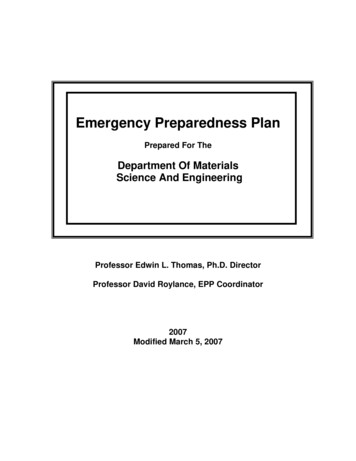
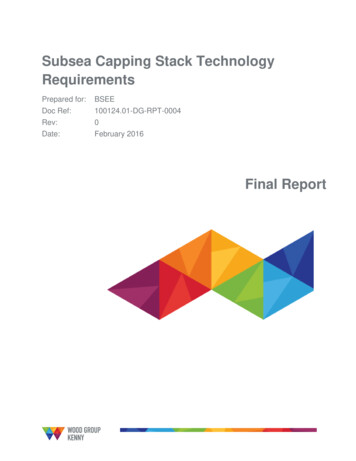
![Index [beckassets.blob.core.windows ]](/img/66/30639857-1119689333-14.jpg)



